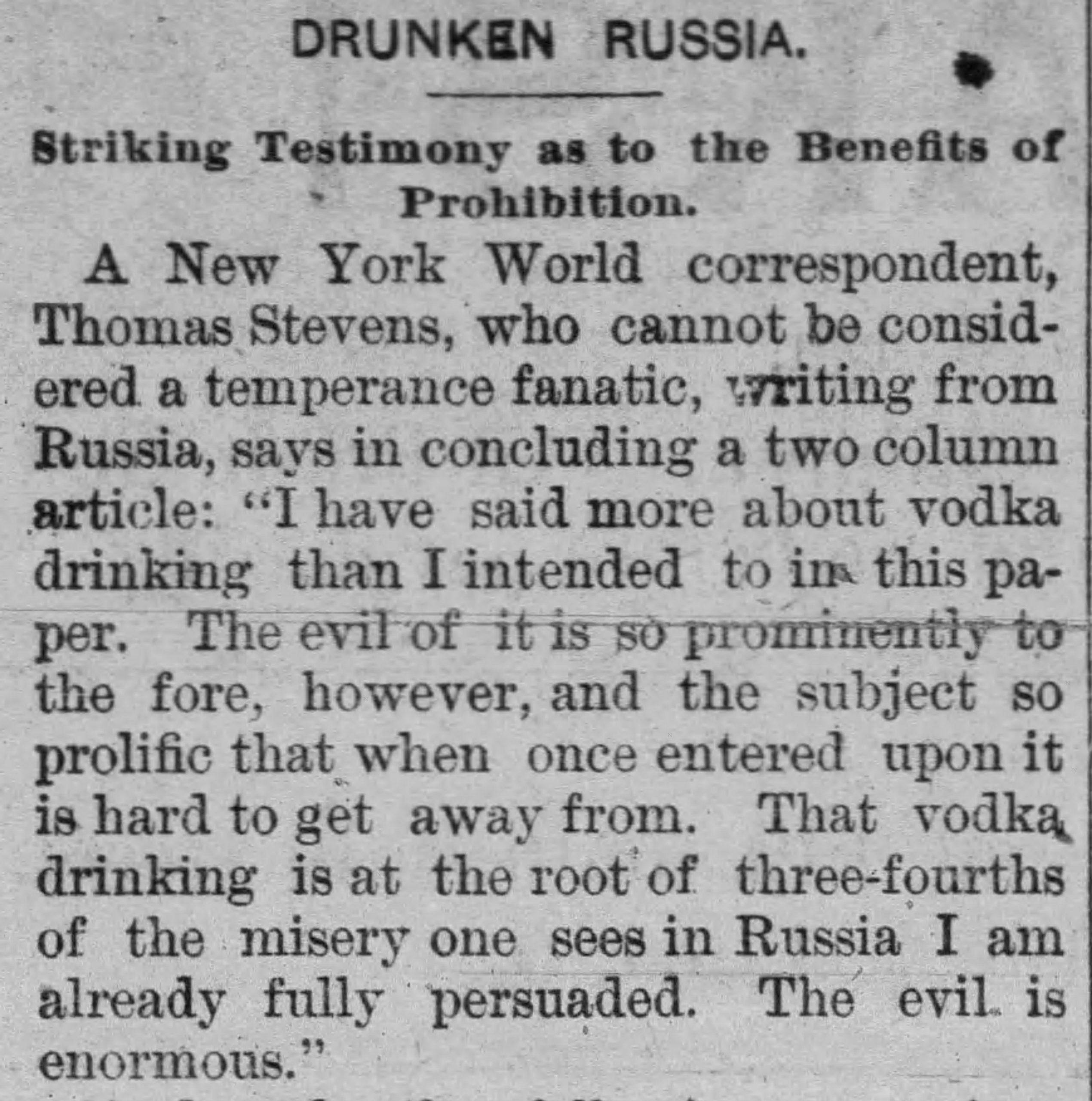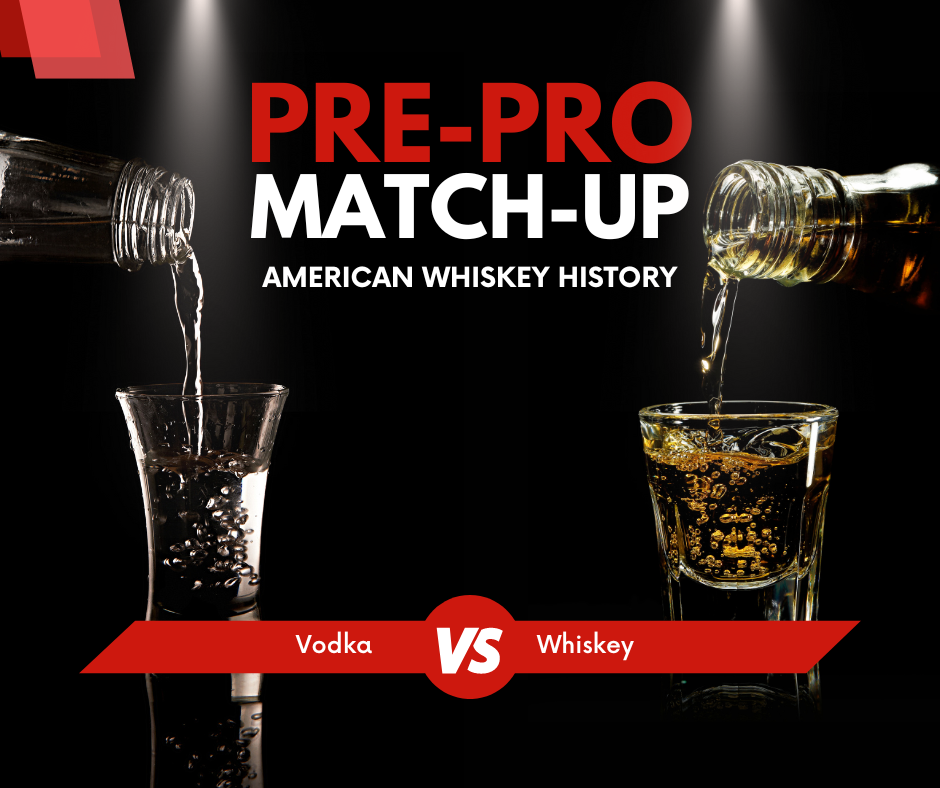Vodka…In America?
America before Prohibition was a nation of whiskey drinkers. I don’t mean to imply that it was alone in the alcohol industry- There were rums, gins, brandies, cordials, beers, etc., of course. But when it came to spirits, whiskey was king. I find it completely within reason that modern day whiskey drinkers, almost a s a rule, disdain American vodka. Notice I say “American vodka” and not vodka in general. When the first standards of identity were drawn up in 1935 by the Federal Alcohol Administration, vodka was not listed. The spirit known as “Vodka” was considered a generically named Russian-made spirit, not just by the American public, but also by the government. What we imagine to be American vodka today was listed under “Class 1: Neutral Spirits or Alcohol” which was defined as “spirits distilled from any material at or above 190 proof, whether or not such proof is subsequently reduced.” Today, the TTB’s definition of vodka remains under the category of neutral spirits or alcohol, but it has been designated as a “type” with its own distinct definition. The traditional vodkas of eastern Europe and Russia, in many cases, do not meet the definition/standards of identity for American vodka. Vodka is now defined as follows:
“Neutral spirits which may be treated with up to two grams per liter of sugar and up to one gram per liter of citric acid. Products to be labeled as vodka may not be aged or stored in wood barrels at any time except when stored in paraffin-lined wood barrels and labeled as bottled in bond pursuant to § 5.88. Vodka treated and filtered with not less than one ounce of activated carbon or activated charcoal per 100 wine gallons of spirits may be labeled as ‘charcoal filtered.’ Addition of any other flavoring or blending materials changes the classification to flavored vodka or to a distilled spirits specialty product, as appropriate. Vodka must be designated on the label as ‘neutral spirits,’ ‘alcohol,’ or ‘vodka’.”
Before Prohibition, most whiskey distilleries made high wines for the rectifying market, and rectifiers used those new-make spirits to make neutral grain spirits. These were used for everything from the production of liqueurs to medicines, but the whiskey market knew that whiskeys cut with neutral grain spirits made “cheap whiskey” and the prices reflected that. The public understood the differences and had options, so even as the Whiskey Trust began to peddle their overproduced “cheap whiskey”, the straight whiskey market was able to push back. This can all be observed during the years after the 1906 Food and Drug Act when rectifiers and “straight whiskey” producers were busy arguing over what should and should not be considered whiskey. Americans knew what vodka was, but they associated it only with Russia and eastern Europe. It was not considered a product that American companies thought to manufacture or sell to the public any more than they would have considered selling “white whiskey.”

The first American vodka distillery was supposedly established in 1934 in Connecticut. Desperate times during Prohibition called for men to make desperate beverage choices. The whiskeys that could be had during the 1920s, albeit illegally, were being cut with neutral grain spirits to stretch the profitability of available stocks. This was that old Whiskey Trust trick from the late 1800s, but this time, the public was more open to the idea of spending more money on “cheap whiskey.” Now, once Repeal created a post-Prohibition landscape for the whiskey industry, distillers COULD have put their efforts behind bringing quality whiskeys back to the American people. Instead, the men that were controlling the industry wanted to firm up their position of power and chose quantity over quality. This may sound like a blanket statement, but it is based in truth. The fact is that many smaller producers attempted to compete in the post-Prohibition market with their own bottled-in-bond straight whiskeys once they came of age after 1937, but most were either chased away or bought out by the larger companies. The public had become used to whiskeys that had been blended down with neutral spirits during the 20s, and their willingness to accept a lesser product was music to the ears of the largest producers. Why wait for years for a superior product when the public is happily willing to buy the inferior one?
It is often said that the post-Prohibition market was determined by the public’s demand for blended whiskeys. I would argue that the public drank what was available and affordable to them. One cannot buy what is not available (OR miss the flavors one barely remembers). Americans did not crave neutral grain spirits. The market encouraged them to do so. Advertisers began to sway the public into believing that neutral grain blends were superior and that certain blends were more elite than others (usually the ones with a higher percentage of actual aged whiskey in them). And who could argue? They were. But when a person has never tried Wagyu beef, a can of beef stew can still seem like a gourmet meal.
The slow movement toward convincing the American public that neutral grain spirits were the height of what American spirits had to offer was inevitable. American vodka- distilled to over 90 proof- is among the most inexpensive distilled products to manufacture and requires no aging. It’s not inexpensive to advertise or maintain its mystique, but it should not come as a surprise to anyone that the distilling industry LOVED the chance to sell vodka to the American people. Neither should it come as a surprise that vodkas from Russia or eastern Europe are made with far more labor and care than those marketed in the US. In many cases, those vodkas would not qualify as “vodka” under today’s US standards of identity anyway. It is worth noting here that vodka WAS mentioned among the FAA’s first standards of identity for the liquor industry in 1935. Vodka was listed under “Class 9: Products Without Geographical Designations But Distinctive if a Particular Place.” The category goes on to explain: “Examples of products which have lost their geographical significance to such an extent that they are no longer distinctive products of a particular place or country, but have become generic, are the following: Vodka, Slivovitz, Zubrovka, Aquavit, Arrack, and Kirschwasser.” Vodka was not listed as a type of “neutral grain spirit” as is today, but listed among the liquors that had lost their provenance in the eyes of the US government.

Ironically, it took the decline of American whiskey to finally usher in a return to pre-Prohibition quality whiskeys. Whiskey is part of American history and our palates have always been partial to sweet, bold flavors. The modern whiskey renaissance has allowed smaller competitors in again. Craft whiskey is reminding us what we’ve been missing and the sales numbers reflect that. Eat your heart out vodka. American whiskey isn’t going anywhere anytime soon.

